The ancient landscapes of Saudi Arabia harbor two remarkable archaeological treasures—Dadan and Jabal Ikmah. These extraordinary sites showcase the Lion Tombs of Dadan, carved with exceptional precision some 50 meters above ground level. Visitors stand before tangible remnants of sophisticated civilizations that flourished along vital trade routes more than 2,500 years ago.
Dadan reveals itself as a formidable trading center that once commanded the north-south caravan route of the famed Incense Road. Archaeological teams have unearthed merely 4% of this ancient city, suggesting vast historical riches still concealed beneath layers of sand. Nearby stands Jabal Ikmah, aptly nicknamed the "Open Library"—a sandstone canvas preserving thousands of inscriptions in six distinct ancient languages, with the oldest dating to 644 BCE. These rock faces essentially functioned as communication hubs where travelers and locals documented their presence and activities.
The sites unfold a rich tapestry of ancient life through their artifacts and carvings. Seated lion sculptures project symbols of power and divine protection, while detailed inscriptions chronicle religious ceremonies, business agreements, and governing principles. Though modern visitors typically explore these heritage locations within a two-hour timeframe, the historical weight they carry extends immeasurably deeper. Together, they offer unparalleled insights into one of northern Arabia's most advanced urban centers during the 1st millennium BCE, where commerce, culture, and civilization converged in remarkable ways.
Nestled within the majestic sandstone formations of AlUla in northwestern Saudi Arabia lies the ancient city of Dadan, once a formidable kingdom boasting a distinctive cultural identity. Archaeological excavations have yielded evidence dating this sophisticated civilization to approximately 800 BCE, revealing a complex society whose influence would echo throughout the region for centuries to come.
The Dadanite kingdom rose to prominence during the 9th-8th century BCE, establishing its capital at Dadan. The historical significance of this settlement extends beyond archaeological findings—the ancient city appears in the Book of Ezekiel in the Hebrew Bible, composed in the 6th century BCE, which documents its commercial relationships with Tire, located in present-day Lebanon.
A significant political transition occurred around the 5th century BCE when leadership transferred to the kings of the Lihyan tribe, though many elements of Dadanite cultural practices persisted through this change. The Lihyanite kingdom expanded to become a dominant regional force, extending territorial control from Medina in the southern reaches to Aqaba (in modern-day Jordan) in the north. These successive civilizations flourished over an astonishing 900-year span, finally declining around 100 CE.
Dadan's extraordinary prosperity largely resulted from its strategically advantageous position along the celebrated Incense Road—an intricate network of trade pathways connecting the southern Arabian Peninsula with markets across Egypt, Rome, and Mesopotamia. During this era, frankincense possessed tremendous economic value, often compared by historians to "oil in modern times."
This aromatic resin, harvested exclusively from trees indigenous to southern Arabia, commanded exceptional demand throughout the ancient world. Frankincense caravans traversing through Dadan subjected merchants to substantial taxation, generating immense wealth that fueled regional prosperity for centuries. Beyond commerce, the kingdom developed sophisticated agricultural systems, implementing innovative water management techniques to support local farming enterprises.
Archaeological evidence presents another fascinating dimension of Dadan's cosmopolitan character—inscriptions reveal the presence of a substantial Minaean trading community from Yemen, situated some 1,800 kilometers southward. This multicultural element created what modern archaeologists characterize as a "very cosmopolitan" social environment.
The most captivating feature of Dadan remains the enigmatic Lion Tombs—burial chambers meticulously carved into sandstone cliffs and adorned with magnificent lion sculptures. These impressive monuments, dating between 600-500 BCE, perch approximately 50 meters above the wadi floor.
The peculiar aspect of these funerary structures lies in their rarity—only two tombs display the distinctive lion embellishments, while the majority of Dadanite burial sites consist of simple square recesses cut into the rock face. According to contemporary religious beliefs, these lions functioned as sacred guardians for the deceased interred within these chambers.
An illuminating inscription discovered at the base of these distinctive tombs provided archaeologists with crucial insight regarding their uniqueness—they belonged to Minaean traders from Yemen, suggesting these foreign merchants sought to preserve their cultural identity even in death, marking their final resting places with symbols distinctly their own.
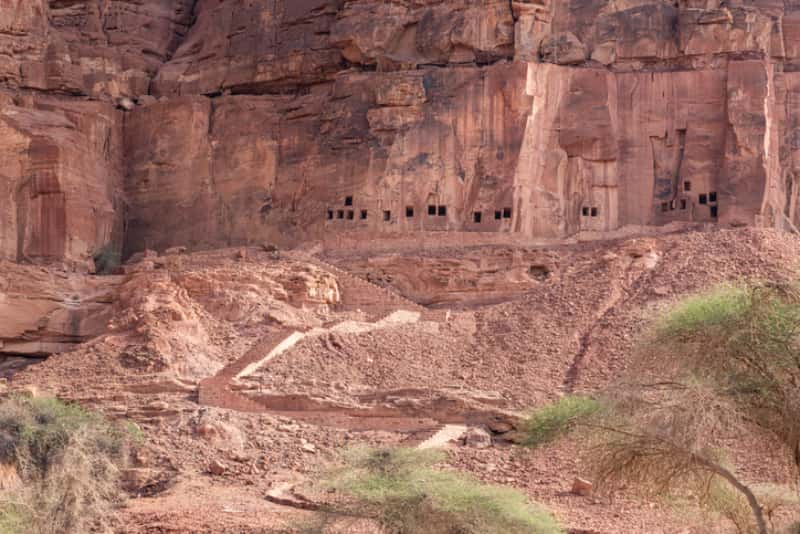
Jabal Ikmah stands proudly near the ancient Dadanite capital, its sandstone surfaces adorned with hundreds of meticulously carved inscriptions. This remarkable mountain sanctuary rightfully earned its designation as AlUla's "open-air library." Visitors find more than 300 historically significant inscriptions etched into its rocky canvas, the majority dating to the second half of the first millennium BCE.
The mountain site rests within a secluded canyon that once welcomed travelers as early as the 1st millennium BCE. Rather than functioning as an academic center, evidence suggests Jabal Ikmah primarily served as a sacred space, drawing both Lihyanites and journeyers passing through AlUla. Curiously, despite a thorough investigation, scholars have yet to determine precisely why so many individuals chose this particular location to document their stories. Fortunate for modern observers, the protective geological features of the mountain have shielded these ancient carvings from centuries of harsh environmental elements, preserving them with minimal deterioration.
Jabal Ikmah presents an astonishing array of linguistic diversity. Its sandstone walls showcase ancient scripts that not only predate Arabic but also significantly influenced its development. Scholars have identified this site as housing the world's largest collection of Dadanitic inscriptions. The mountain's surfaces also bear textual evidence in Aramaic, Safaitic, Thamudic, Minaic, and Nabataean languages. The Dadanitic alphabet itself reveals sophisticated linguistic structure, written right to left using 28 distinct letter forms and employing vertical lines or double dots to separate individual words. These varied inscriptions offer scholars crucial insights into the evolutionary path of the Arabic language.
The mountain's engravings unveil captivating scenes of ancient daily existence. Carved messages document religious ceremonies, business dealings, and societal regulations. Numerous inscriptions record devotional offerings to the Lihyanite deity Dhu Ghaybat, frequently referencing a ritual practice known as "zll". The stylistic variation among these carvings proves equally telling—some appear casual, merely names hastily scratched into stone, while others display formal characteristics suggesting the handiwork of trained scribes. Complementing these written records, the site features detailed petroglyphs showing human figures engaged in hunting expeditions and agricultural activities, alongside depictions of local fauna including camels, bulls, sheep, goats, and deer.
UNESCO formally acknowledged Jabal Ikmah's extraordinary historical significance in 2023, adding it to the prestigious Memory of the World Register for its unparalleled contribution to documenting the evolution of Old Arabic languages and dialects.
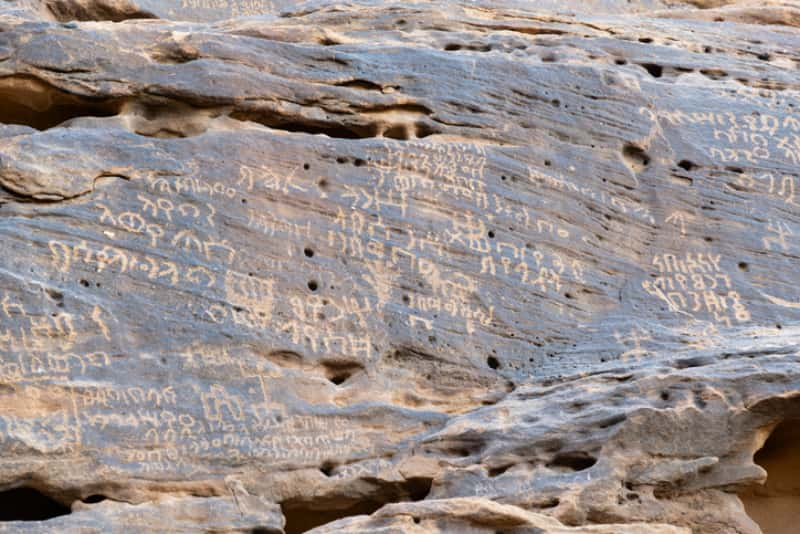
The sand-swept landscape of AlUla conceals millennia-old secrets gradually coming to light under the careful hands of archaeologists. April 2019 marked the launch of the Dadan Archaeological Project (DAP), a five-year program representing the most ambitious research initiative ever undertaken at these ancient sites.
Early excavation efforts at Dadan focused primarily on the main sanctuary area. Today's project has expanded dramatically under the joint leadership of Dr. Jérôme Rohmer (CNRS) and Dr. Abdulrahman Alsuhaibani (RCU). Their French-Saudi team conducts large-scale excavations, systematic surveys, and specialized studies across multiple disciplines—epigraphy, ceramology, archaeozoology, and archaeobotany.
Recent work has yielded extraordinary discoveries. Meticulous excavations have uncovered the earliest safely dated archaeological remains within the oasis, connected to the first evidence of local date palm cultivation, reaching back to the 12th-11th centuries BCE. Specialists have identified a substantial flourishing period in oasis development during the 8th-5th centuries BCE, perfectly aligning with the emergence of North-Arabian kingdoms and the establishment of long-distance aromatics trade networks.
Jabal Ikmah continues revealing its historical bounty, with archaeologists now having documented more than 450 early Arabic inscriptions throughout the site. Among these textual treasures sits one of the oldest inscriptions from the Islamic era, definitively dated to 24AH (644 CE).
Written records tell only part of the story. Teams have documented intricate rock art portraying the region's ancient fauna—deer leaping across stone canvases, goats perched on rocky outcrops, and camels traversing imagined deserts. These artistic expressions illuminate the profound connection ancient inhabitants maintained with their surrounding environment.
Numerous mysteries persist despite years of careful study. Archaeologists actively investigate the puzzling circumstances behind Dadan's sudden and apparently catastrophic downfall. Ceramic analysis has identified 16 distinct macrofabrics spanning from the late third millennium BCE through the early first millennium CE—each telling a different chapter of regional development.
Place names etched into stone inscriptions present another fascinating avenue of research. Scholars believe confirming locations like Bdr and Dmn might demonstrate that Lihyanite influence extended hundreds of miles beyond Dadan's immediate vicinity. This extensive research program seeks to construct a comprehensive understanding of these once-vibrant civilizations—their chronology, physical layout, material culture, and economic systems that sustained prosperity across centuries.
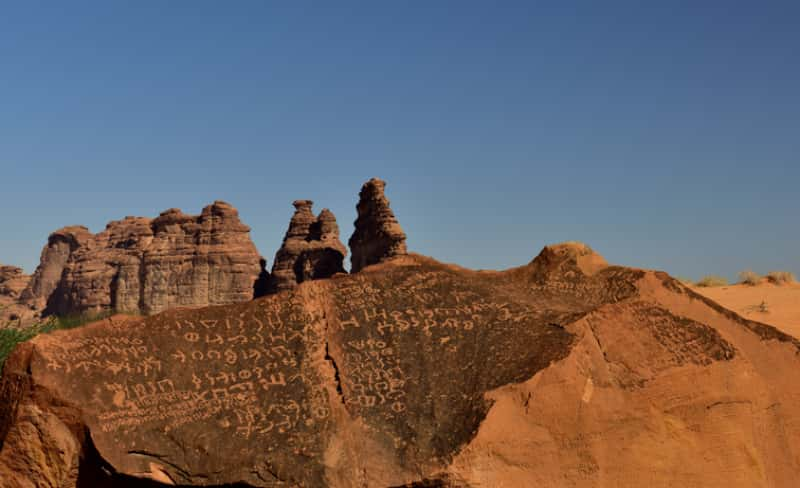
Dadan and Jabal Ikmah have ascended to prominence within global heritage circles, garnering international recognition for their exceptional historical value. These ancient wonders now benefit from meticulous preservation initiatives as Saudi Arabia directs significant resources toward safeguarding its archaeological patrimony.
Jabal Ikmah reached a pivotal milestone on May 24, 2023, when UNESCO formally inscribed it into the prestigious Memory of the World Register. This distinction celebrates the site's 450 historically significant carved inscriptions, most originating from the second half of the first millennium BCE. The sandstone surfaces of Jabal Ikmah preserve the most extensive collection of inscriptions documenting the ancient Dadanite Kingdom's religious ceremonies, everyday activities, and diplomatic relationships with surrounding peoples.
This accolade represents the second major UNESCO recognition bestowed upon AlUla, following Hegra (Mada'in Salih), which earned distinction as Saudi Arabia's inaugural World Heritage Site in 2008. UNESCO specifically acknowledged both the authenticity and integrity of information preserved about these ancient societies, alongside the remarkable conservation state of the site itself.
Saudi Arabia's preservation vision crystallizes in the ambitious Journey Through Time Masterplan, a sweeping initiative aimed at developing and restoring archaeological sites throughout AlUla by 2035. This elaborate blueprint encompasses five distinctive districts spanning the 20-kilometer cultural heart of AlUla: Old Town, Dadan, Jabal Ikmah, Nabataean Horizon, and Hegra Historical City.
Dadan and Jabal Ikmah function as cornerstone elements within this master plan, exemplifying the harmonious marriage between natural landscapes and historical treasures. The framework draws upon exhaustive scientific investigations into AlUla's human settlement patterns, environmental conditions, and geological evolution. When fully realized, this master plan promises to elevate AlUla into a world-class destination celebrating heritage, culture, and natural splendor.
How Saudi Arabia is preserving its heritage
The Royal Commission for AlUla (RCU) spearheads preservation endeavors, channeling substantial resources into researching and protecting landmarks like the ancient city of Dadan and Jabal Ikmah. Working alongside UNESCO, the RCU has established initiatives to identify the specific requirements of memory institutions regarding documentary heritage throughout Saudi Arabia.
The jewel in these conservation efforts is the Kingdoms Institute, currently taking shape within Dadan Oasis. This facility will specialize in examining and interpreting artifacts through cutting-edge scientific methodologies. These heritage preservation undertakings align seamlessly with Vision 2030, simultaneously boosting tourism potential, diversifying economic activities, and enhancing the Kingdom's cultural prominence on the global stage.
These preservation campaigns reflect Saudi Arabia's dedication to sharing AlUla's extraordinary legacy with international visitors while ensuring its protection for generations yet to come.
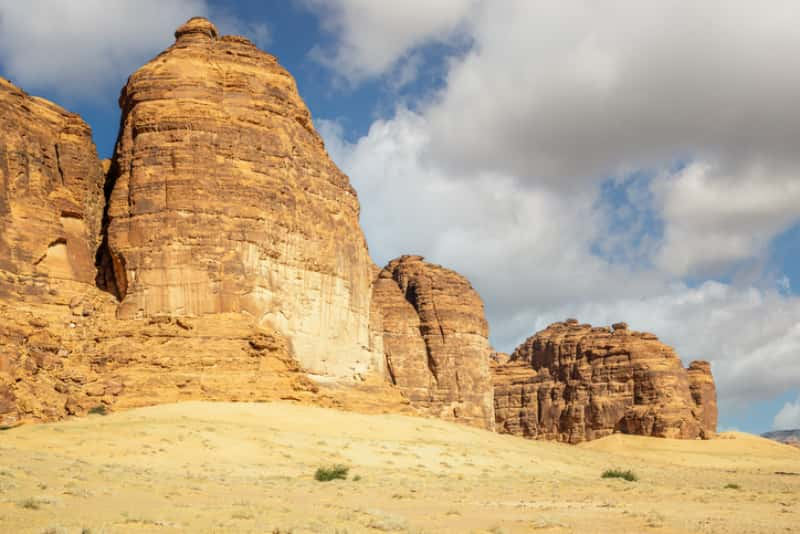
Dadan and Jabal Ikmah represent extraordinary portals into ancient Arabian civilization, revealing intimate details of life along bustling trade routes more than 2,500 years ago. The Lion Tombs, masterfully carved 50 meters above ground level, alongside thousands of inscriptions in six distinct languages, chronicle tales of governance, trade, and cultural intermingling. Positioned strategically along the profitable Incense Road, these settlements evolved into wealthy kingdoms that flourished across nearly nine centuries.
Modern archaeological teams continue to make remarkable discoveries, despite having explored merely 4% of Dadan city to date. Every unearthed artifact—whether evidence of early date palm cultivation or stone-carved records of religious ceremonies—contributes another fragment to this historical mosaic. Saudi Arabia's Journey Through Time Masterplan stands as an essential framework for safeguarding these treasures while creating meaningful access points for curious visitors.
UNESCO's formal recognition of Jabal Ikmah within the Memory of the World Register confirms the worldwide importance of these archaeological treasures. This ancient "open library" paired with the forgotten kingdom of Dadan offers unmatched perspectives on Arabic language evolution, regional commercial networks, and cultural traditions. Walking among these weathered sandstone cliffs and ancient structures connects visitors not simply to Saudi Arabian heritage but to a pivotal chapter of human civilization—one that promises further astonishing revelations as meticulous exploration progresses.
Q1. What makes Dadan and Jabal Ikmah significant archaeological sites?
Dadan and Jabal Ikmah are important archaeological sites in Saudi Arabia that offer insights into ancient civilizations from over 2,500 years ago. Dadan was a powerful trading center along the Incense Road, while Jabal Ikmah contains thousands of inscriptions in multiple ancient languages, serving as an open-air library.
Q2. What are the Lion Tombs of Dadan?
The Lion Tombs are rock-cut burial chambers in Dadan, carved 50 meters above ground level. They feature lion sculptures and are believed to have belonged to Minaean traders from Yemen. These tombs, dating back to 600-500 BCE, symbolize divine protection for the deceased.
Q3. How many languages can be found in the inscriptions at Jabal Ikmah?
Jabal Ikmah features inscriptions in six different ancient languages: Dadanitic, Aramaic, Safaitic, Thamudic, Minaic, and Nabataean. This linguistic diversity provides valuable insights into the development of the Arabic language and the cultural exchanges of the region.
Q4. What recent discoveries have been made at these sites?
Recent excavations have uncovered evidence of local date palm cultivation dating back to the 12th-11th centuries BCE, making it the earliest dated archeological remains in the oasis. Researchers have also identified a peak in oasis development during the 8th-5th centuries BCE, coinciding with the rise of North-Arabian kingdoms.
Q5. How is Saudi Arabia working to preserve these archaeological sites?
Saudi Arabia is preserving these sites through the Journey Through Time Masterplan, which aims to develop and restore archeological sites across AlUla by 2035. The Royal Commission for AlUla leads conservation efforts, and the Kingdoms Institute is being established to study and analyze artifacts using advanced scientific methodologies.
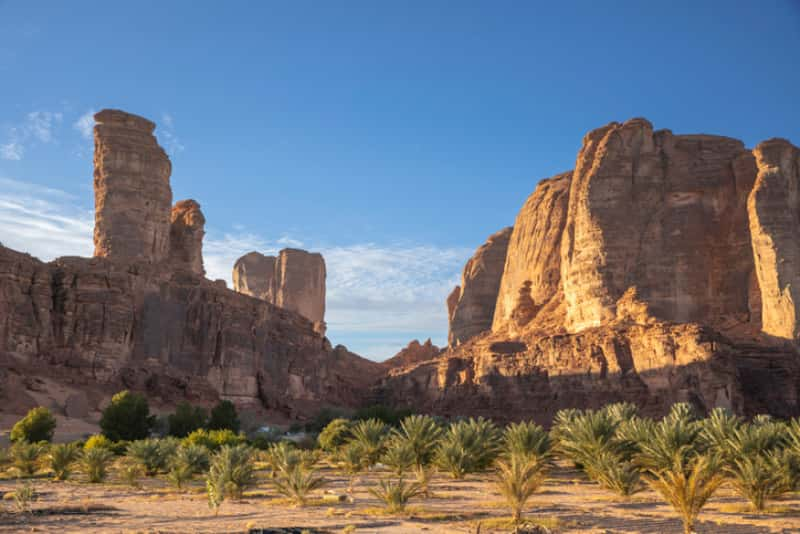
Find Related Tours


© Copyright 2024 Go Saudi Arabia Trips. All Rights Reserved.